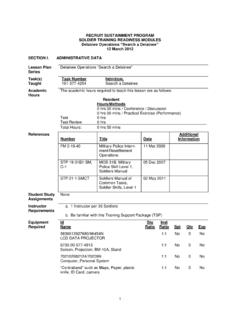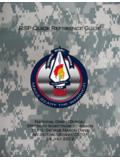Transcription of RECRUIT SUSTAINMENT PROGRAM SOLDIER TRAINING …
1 1 RECRUIT SUSTAINMENT PROGRAM SOLDIER TRAINING READINESS MODULES Convoy Operations 12 March 2012 SECTION I. ADMINISTRATIVE DATA Lesson Plan Series Convoy Operations Task(s) Taught Task Number INDIVIDUAL 071-326-3002 React to Indirect Fire While Mounted 071-326-3013 Conduct a Tactical Road March 071-410-0002 React to Direct Fire While Mounted 093-401-5040 React to Unexploded Ordnance Hazards Academic Hours The academic hours required to teach this lesson are as follows: Resident Hours/Methods 0 hrs 10 mins / Conference / Discussion 0 hrs 40 mins / Practical Exercise (Performance) Test 0 hrs Test Review 0 hrs Total Hours: 0 hrs 50 mins References Number Title Date Additional Information FM 55-30, C-1 Army Motor Transport Units and Operations 27 Jun 1997 Chapters 5, 6 and App O FM 5-19 Composite Risk Management 21 Aug 2006 STP 21-1-SMCT SOLDIER 's Manual of Common Tasks, Warrior Skills, Level 1 02 May 2011 Student Study Assignments None Instructor Requirements a.
2 1 Instructor per 35 Soldiers b. Be familiar with this TRAINING Support Package (TSP) 2 Equipment Required Id Name Stu Ratio Inst Ratio Spt Qty Exp 2320-01-354-3385 TRUCK CARGO: 4X4 LMTV W/E 1:1 No 0 No 1005-01-128-9936 M16A2 Rifle 1:1 No 0 No 4240-01-258-0061 Mask, Chemical Biological M40 1:1 No 0 No 8470-01-465-1867 Interceptor Body Armor 1:1 No 0 No Helmet, Kevlar 1:1 No 0 No Materials Required Instructor Materials: a. This TRAINING Support Package (TSP) Student Materials: a. Other materials as directed by RSP Unit SOP Classroom, TRAINING Area, and Range Requirements Organizational Classroom Instructional Guidance NOTE: Before presenting this lesson, instructors must thoroughly prepare by studying this lesson and the identified reference material.
3 NOTE: This Convoy Operations TRAINING will be part discussion and part demonstration. The first part being an informal class covering individual skills and collective tasks associated with convoy operations through a potentially hostile environment. The second part, intermingled throughout the class is a Convoy Operations Situational TRAINING Exercise (STX). 3 SECTION II. INTRODUCTION NOTE: SHOW Slide 1 (STRM) Method of Instruction: Conference / Discussion Instructor to Student Ratio is: 1:35 Time of Instruction: 5 mins Media: None Motivator Every one of you may have heard the stories of attacks on convoys, and for the most part, what you hear is accurate. We are going to take those horror stories and break them down, giving you an accurate detailed picture of what the enemy is looking for, and what you can do to stop their action and retaliate with such strength that the enemy will be thrown off guard and you will gain the upper hand.
4 Terminal Learning Objective NOTE: SHOW Slide 2 (Terminal Learning Objective) NOTE: Inform the students of the following Terminal Learning Objective requirements. At the completion of this lesson, you [the student] will: Action: Implement Defense Procedures during a Tactical Convoy Conditions: While traveling in the passenger seat or cargo section of a hardened vehicle that is part of a tactical road march; wearing full combat gear with an M16/M4 Series Rifle; in the contemporary operating environment Standards: Take action to identify and eliminate threats to the convoy while maintaining security and situational awareness Safety Requirements Conduct a safety brief prior to TRAINING as needed and IAW unit and installation policies.
5 Risk Assessment Level Low - Risk Assessment to be produced locally IAW FM 5-19, August 2006. Evaluation None Instructional Lead-In In short, the enemy wants to stop your movement, isolate soft (easy) targets, and kill as many American Soldiers as possible, with back up plans to try to break your resolve and make political statements heralding their bravery and strength. This lesson plan will teach you how to make the best out of a very dangerous situation by protecting your vehicle as well as you and your fellow Soldiers. 4 SECTION III. PRESENTATION 1. Learning Step / Activity 1. Remove Materials from Hardened Vehicle Method of Instruction: Practical Exercise (Performance) Instructor to Student Ratio: 1:35 Time of Instruction: 5 mins Media: None NOTE: The primary Instructor uses an already hardened vehicle to point out the features to the students.
6 NOTE: The Instructor may embellish personal experience on vehicle hardening of differing types of vehicles. a. The following criteria must be met in hardening a vehicle. The Soldiers will be broken into groups of 10 Soldiers per truck and remove all hardening materials from the vehicle to start. (1) The cargo bed of the truck has a layer of sandbags at least one deep covering the entire bed. (2) The sides of the cargo bed have been reinforced with walls of sandbags that are at least one wide and at least five deep. (3) The front of the cargo bed has a wall of sandbags extending from the floor to a level that provides protection for any SOLDIER covering the front arc of the vehicle. (4) The cab of the truck has a one-deep layer of sandbags covering the floors and sides of the cab as much as possible without interfering with the operation of the vehicle's controls.
7 (5) Any tarps or coverings for the cargo bed have been removed. (6) All sandbags are secured to the vehicle frame in order to prevent shifting during vehicle movement. 2. Learning Step / Activity 2. Demonstrate Vehicle Mounting Procedures Method of Instruction: Practical Exercise (Performance) Instructor to Student Ratio: 1:35 Time of Instruction: 10 minutes Media: None NOTE: The Instructor either uses a squad of Soldiers that has rehearsed this task previously, or uses permanent party cadre that have been certified to demonstrate the task. The squad should demonstrate one technique both for loading and unloading. There are no right or wrong methods of loading or unloading a tactical vehicle so long as the squad adheres to the following principles.
8 A. Weapons must be positioned where they can employ their firepower against likely threats. b. The unit maintains 360-degree security throughout the loading or unloading process. c. Weapons remain on safe throughout the process unless actively engaging an enemy target. 5 d. Without sacrificing security or safety, the squad/section must load or unload as quickly as possible. It should take no more than thirty seconds to load or unload a squad of Soldiers. e. Soldiers understand what actions to take if the squad and/or vehicle come under direct or indirect fire. f. Leaders position themselves where they can best influence the operation. NOTE: The primary instructor briefly explains the six principles and points out how the demonstrated technique meets them.
9 3. Learning Step / Activity 3. React to Ambush while Mounted Method of Instruction: Practical Exercise (Performance) Instructor to Student Ratio: 1:35 Time of Instruction: 5 minutes Media Slide: None NOTE: The primary instructor either uses a squad of trainees that has rehearsed this task previously, or uses permanent party cadre that have been certified to demonstrate the task. The demonstration must meet the following standards. a. Demonstrate the following performance standards for NEAR ambush: (1) Reports ambush to convoy commander immediately upon contact using analog and/or digital communications. (2) Identifies threat location. (3) Non-driving personnel return aggressive fire to neutralize the threat.
10 Fire should be in short bursts of three rounds each. (4) Vehicle driver increases speed and clears the kill zone. (5) Keeps roadway clear by pushing disabled vehicles aside. (6) Returns fire while transiting the kill zone or while targets are in sectors of fire and maneuver of security elements to allow remaining vehicles to pass through the kill zone (senior member present). (7) Senior member present forwards SITREP to convoy /unit commander using analog and/or digital communications. (8) Consolidates and reorganizes while awaiting further orders from convoy commander (consolidation and reorganization includes the treatment and evacuation of casualties). 4. Learning Step / Activity 4.



